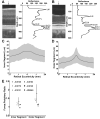Arrested development: high-resolution imaging of foveal morphology in albinism
- PMID: 20149815
- PMCID: PMC2838989
- DOI: 10.1016/j.visres.2010.02.003
Arrested development: high-resolution imaging of foveal morphology in albinism
Abstract
Albinism, an inherited disorder of melanin biosynthesis, disrupts normal retinal development, with foveal hypoplasia as one of the more commonly associated ocular phenotypes. However the cellular integrity of the fovea in albinism is not well understood - there likely exist important anatomical differences that underlie phenotypic variability within the disease and that also may affect responsiveness to therapeutic intervention. Here, using spectral-domain optical coherence tomography (SD-OCT) and adaptive optics (AO) retinal imaging, we obtained high-resolution images of the foveal region in six individuals with albinism. We provide a quantitative analysis of cone density and outer segment elongation demonstrating that foveal cone specialization is variable in albinism. In addition, our data reveal a continuum of foveal pit morphology, roughly aligning with schematics of normal foveal development based on post-mortem analyses. Different albinism subtypes, genetic mutations, and constitutional pigment background likely play a role in determining the degree of foveal maturation.
Copyright 2010 Elsevier Ltd. All rights reserved.
Figures




References
-
- Abadi RV, Pascal D. The recognition and management of albinism. Ophthalmic & Physiological Optics. 1989;9:3–15. - PubMed
-
- Akeo K, Shirai S, Okisaka S, Shimizu H, Miyata H, Kikuchi A, Nishikawa T, Suzumori K, Fujiwara T, Majima A. Histology of fetal eyes with oculotaneous albinism. Archives of Ophthalmology. 1996;114:613–616. - PubMed
-
- Bennett AG, Rudnicka AR, Edgar DF. Improvements on Littmann's method of determining the size of retinal features by fundus photography. Graefe's Archive for Clinical and Experimental Ophthalmology. 1994;232:361–367. - PubMed
-
- Bixenman WW, Von Noorden GK. Apparent foveal displaceent in normal subjects and in cyclotropia. Ophthalmology. 1982;89:58–62. - PubMed
Publication types
MeSH terms
Grants and funding
LinkOut - more resources
Full Text Sources

